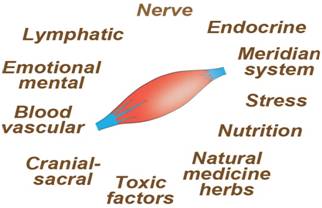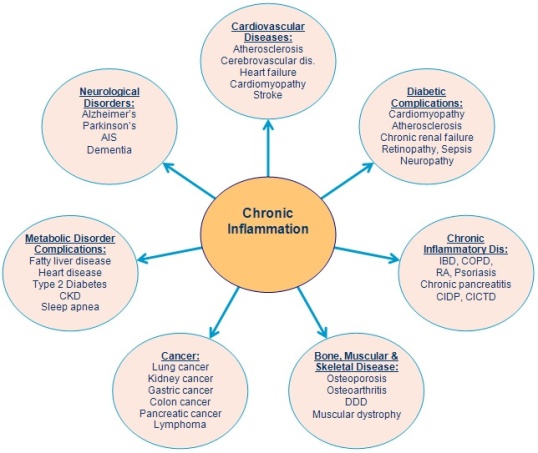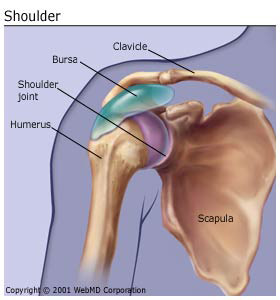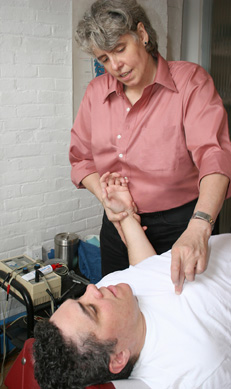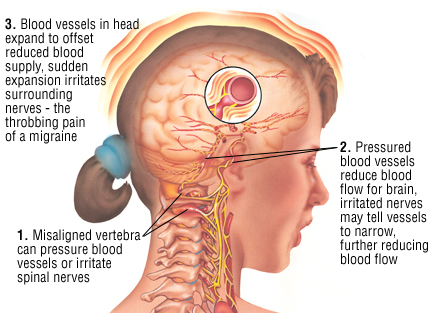A patient comes in with a problem, maybe low back pain. Most chiropractors would figure out what vertebrae /spinal nerve is involved and then adjust the segments involved.
However what is missed is why did the problem happen and how can it be fixed so that it does not happen again.
First we need to look at the muscles innervated by the spinal segment
As a Applied Kinesiologist, I test for the function of individual muscles. For example, we may find the latissimus dorsi muscle weak; that is a muscle that internally rotates, extends and adducts the arm/ shoulder. It also attracts into the lumbar and sacral vertebra and part of the pelvic crest. The weakness may seen either as a higher shoulder on the weak side or a rotation of the lumbar vertebrae. The questions to be asked are: why is the muscle weak? Is the muscle on the other side hypertonic or “too stronger.”
Is there a problem with the vascular or lymphatic drainage of that muscle? Is there a problem with the cranial-sacral system?
Is there a Lovett Brother association where a twisting of the spinal meninges affects an upper vertebrae as well as a low back spinal segment.
As a NKT practitioner, I ask “Is there a dysfunction in the coordination of muscles working in patterns?”
Is the above mentioned latissimus dorsi inhibited by the muscles that attach to the shoulder like the upper or middle trapezius or the levator scapulae or is it compensating (facilitating) for weak or inhibited muscles like the gluteus maximus or the quadratus lumborum or core muscles, for example.
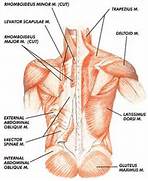
Is the patient using their neck muscles in the movement of their low back?
NeuroKinetic Therapy works with the concept that movement is performed in systems or patterns. The human brain has an affinity toward habits.
NKT identifies muscle imbalances by using muscle testing to determine what muscles are inhibited and what muscles are compensating (facilitating)for them.
I would test the muscles involved in the problematic movement. After an inhibited/weak muscle is found, I would muscle test a synergistic (a helper muscle) or an antagonist muscle (an opposing muscle} which is strong/facilitated that may be affecting the inhibited muscle.
That facilitated muscle would be therapy localized (the muscle is either touched or put in motion) and the inhibited muscle retested. If the TL strengthens the inhibited muscle, then I know that the TLed muscle is affecting the inhibited muscle.
And I can use AK techniques to release the TLed muscle. The inhibited muscle is then retested which should test strong now, the retesting causes a “neural lock” which reprograms the motor control center in the brain.
After balance is restored to the muscles, the vertebrae ( or extremity joint) are adjusted.
Stretches are given to the previously facilitated muscles and exercises given to the previously inhibited muscles in order to break the pattern that caused the problem.
For more detailed information, please click on the following blogs:
http://neurokinetictherapy.com/what-is-neurokinetic-therapy
https://drvittoriarepetto.wordpress.com/2010/06/21/muscle-balancing-in-applied-kinesiology/
https://drvittoriarepetto.wordpress.com/2010/05/17/cranial-sacral-therapy-in-applied-kinesiology/
© 2016-Dr. Vittoria Repetto
Muscles, Connective Tissue Between Organs Influence Illness
Want more information on Dr. Vittoria Repetto and her NYC Applied Kinesiology/Chiropractic/ NKT practice at 230 W 13th St., NYC 10011; please go to www.drvittoriarepetto.com
And please check out the Patient Testimonials page on my web site.
Want to be in the know on holistic information and postings?
https://www.facebook.com/wvillagechiropracticappliedkinesiologynkt/
Or join me at Twitter: www.twitter.com/DrVRepetto
